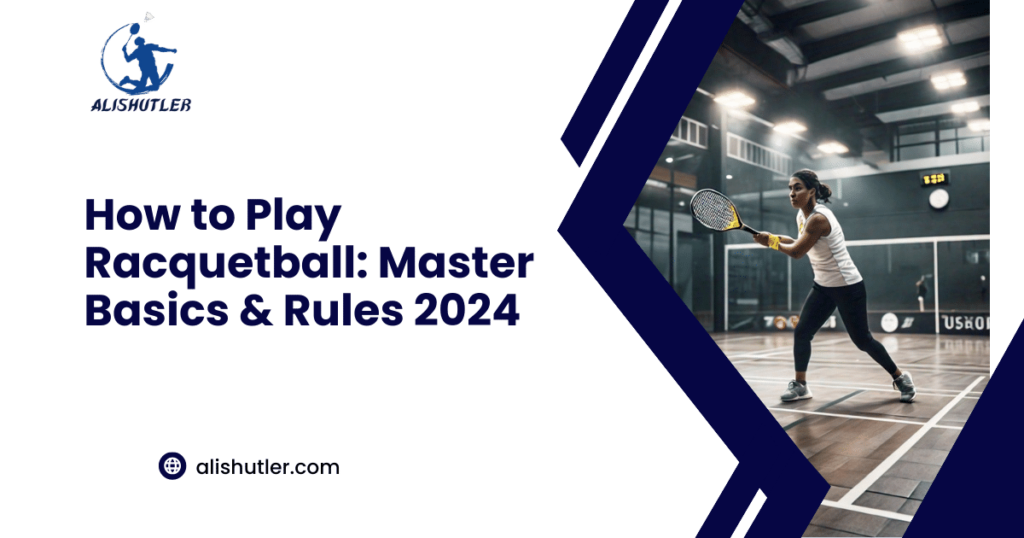An interesting fact you may know about is that Racquetball is a more effective calorie burner than tennis or golf for 30 minutes or less of play. If you are not yet sensitive to exercise and proper weight control because of laziness or whatever reasons you may have then playing racquetball may be your new best choice – a sport for hitting the ball using racquets and making it bounce off the walls. Learning how to play racquetball from scratch or how to improve one’s skills may be a thrill and a good strategy to improve playing on the court.
Racquetball is a sport that requires physical movement and physical coordination of the full body, and it has been proven that Racquetball is a great physical exercise for processing the overall development of the cardiovascular system and the development of coordination between the eyes and hands. Here, one will learn the basics of the game, mastery of dishing out diverse serves, as well as the varying shot types that one should use to win the game.
Key Takeaways
- Start with the Basics: Before diving into advanced strategies, ensure you have a solid understanding of the fundamental rules and techniques of racquetball. Building a strong foundation will set you up for success.
- Gear Up for Success: Investing in the right gear, such as a quality racquet and protective eyewear, is essential for both safety and performance on the court. Proper equipment can enhance your game and prevent injuries.
- Practice Makes Perfect: To excel in racquetball, focus on consistent practice to improve your skills and familiarize yourself with different game scenarios. Repetition and dedication are key to mastering winning strategies.
- Adapt Your Game: Be flexible in your approach and adapt your playing style based on whether you are playing singles or doubles. Understanding the dynamics of each format will help you strategize effectively and outmaneuver your opponents.
- Stay Within the Lines: Pay close attention to the court lines and understand their significance in gameplay. Utilize the court boundaries to your advantage by positioning yourself strategically and anticipating your opponent’s moves.
- Embrace Variety: Challenge yourself by exploring different variations of racquetball, such as cutthroat racquetball, to enhance your skills and adaptability on the court. Trying new formats can broaden your experience and make you a more versatile player.
Basics of Racquetball
Proper Grip
To achieve success in racquetball you have to execute the right modifications on how you hold or grip your racquet to ensure effective and strong conclusion of your shots. Learning how to hold a bat allows the player to play the game with a greater level of accuracy and efficiency. To hit the ball, one has to hold the racquet effectively by placing it in the dominant hand and reinforcing the possession with the hand on the opposite side of the body. It helps strengthen the balance and control on the court which enables more precision in shooting.
Basic Footwork
Dribble in the air to move around the court faster using only the feet. Its main advantage is the ability to prevent the opponent from making good returns by playing tall making it difficult but easy when the player is light on their feet thus there will be speed to intercept good returns.
Practice shuffling your feet to quickly reach different areas of the court. By maintaining a balanced stance and being light on your feet, you can react faster to your opponent’s shots and maintain control of the game.
Scoring System
Understanding the scoring system in racquetball is essential for tracking progress and determining the winner of each game. Familiarize yourself with how points are earned and lost during a match.
In racquetball, games are typically played to 15 points, with players earning points when they win rallies. Pay attention to service rules as they directly impact scoring opportunities throughout the game.
Essential Gear for Players
Eye Protection
Eye protection can also be invested in to avoid eye injuries that may be incurred during racquetball games. Soccer has to be one of the most dangerous sports because it is being played at high speeds necessitating the need to protect the eyes from balls. Special glasses play in the defense and allow you to concentrate on the game without being distracted by failures in it.
Footwear Selection
Choose appropriate footwear with good traction when playing racquetball. The constant movement and quick direction changes in the game require shoes that provide stability and support. Proper footwear not only enhances your performance but also reduces the risk of slipping or falling on the court.
Clothing Comfort
Wear comfortable clothing that allows flexibility and movement while playing racquetball. Opt for outfits that are lightweight, breathable, and moisture-wicking to keep you comfortable throughout intense matches. Clothing that enables a full range of motion is essential for agility and swift movements on the court.
Grasping the Rules Quickly
Serving Rules
Understanding the serving rules is crucial to kickstart a racquetball game effectively. Each player takes turns serving from the service box, aiming to hit the front wall first. A serve must land beyond the short line and below the outline of the service zone to be considered valid.

Mastering these details ensures a fair start to every match. By following the correct serving procedure, players can initiate rallies smoothly and set the tone for an engaging game.
Scoring System
In racquetball, points are scored during rallies when a player fails to return the ball before it bounces twice or hits an illegal shot. Understanding how points are earned is essential for players to strategize and capitalize on their opponent’s mistakes.
The scoring system in racquetball follows a simple format: matches consist of either best-of-three games or best-of-five games, with each game played up to 15 points. This straightforward system allows players to track progress easily and stay motivated throughout the match.
Court Positioning
Court positioning plays a vital role in anticipating shots and gaining a competitive edge in racquetball. By positioning yourself strategically on the court, you can anticipate shots more effectively, react swiftly to your opponent’s moves, and maintain control over rallies.
Effective court positioning involves staying close to the center line to cover more ground efficiently and being ready to move quickly in all directions. By mastering this aspect of the game, players can outmaneuver their opponents and dictate play during intense exchanges.
Mastering Winning Strategies
Vary Shots
Practice varying your shots during a racquetball game to keep your opponent guessing. By mixing up your shots, such as using lobs, ceiling balls, and pinches, you can create uncertainty for your opponent.
Utilize angles when hitting the ball to create difficult shots for your opponent. Aim to hit the ball at sharp angles that bounce off the walls unpredictably, making it challenging for your opponent to anticipate and return the shot effectively.
Strategic Game Plan
Develop a strategic game plan by analyzing both your strengths and weaknesses along with those of your opponent. Identify areas where you excel, such as powerful serves or quick footwork, and leverage these strengths during the game.
Consider your opponent’s weaknesses, whether they struggle with backhand shots or moving quickly across the court. Tailor your strategy to exploit these weaknesses while minimizing the impact of their strengths on the game.
Playing Singles Effectively
Control Center
Position yourself strategically in the center of the court to dominate play. By controlling this area, you limit your opponent’s options and increase your chances of winning points.
Maintaining a strong presence in the center allows you to react quickly to shots from all angles, giving you an edge over your opponent. This positioning also helps you cover more ground efficiently, reducing the risk of being caught off guard.
Deception Shots
Incorporate deception into your shots to keep your opponent on their toes. Varying the speed, angle, and placement of your shots can confuse your opponent and make it harder for them to anticipate your moves.
By mixing up your shots with slices, lobs, and drops, you create uncertainty in your opponent’s mind, forcing them to react quickly and potentially make mistakes. Mastering the art of deception can give you a significant advantage on the court.
Mental Sharpness
Maintain mental sharpness throughout the match to stay focused and make sound decisions under pressure. Avoid getting distracted by previous points or mistakes; instead, focus on each rally as a new opportunity to score.
Developing a routine between points can help you stay mentally prepared and maintain a consistent pace. Take deep breaths, visualize successful plays, and stay positive even during challenging moments. A strong mental game is often the key to success in racquetball.
Exploring Doubles Dynamics
Partner Coordination
When playing doubles in racquetball, it’s crucial to coordinate with your partner effectively. By covering different areas of the court, you can strategically position yourselves to respond to your opponents’ shots. This coordination ensures that no part of the court is left unguarded, increasing your chances of winning points.

Communication plays a vital role in successful doubles gameplay. Clear and concise communication with your partner helps in avoiding collisions on the court and enhances overall teamwork. By signaling your intentions and movements, you can prevent misunderstandings and work seamlessly together to outplay your opponents.
Player Roles
Understanding the specific roles of each player is key to optimizing your performance in doubles racquetball. One player typically takes up the front position, focusing on quick reflexes and close-range shots near the net. The other player usually covers the backcourt, retrieving deep shots and setting up offensive plays for their partner.
- Pros:
- Enhanced court coverage
- Improved strategic gameplay
- Better shot opportunities
- Cons:
- Increased need for effective communication
- Dependency on partner’s performance
Trying Cutthroat Racquetball
Adapting Strategy
In cutthroat racquetball, players face the challenge of competing against two opponents simultaneously. This dynamic requires adapting your strategy to handle the increased pressure and unpredictability.
Adjusting your gameplay involves anticipating the movements and shots of both opponents, strategically positioning yourself to cover more ground efficiently. By staying alert and focused, you can seize opportunities to capitalize on openings created by your opponents’ positions.
Agility and Quickness
Being agile and quick is essential in cutthroat racquetball to navigate the court effectively. With multiple opponents vying for control, speed becomes a crucial asset in reaching shots and returning volleys promptly.
Quick reflexes allow you to react swiftly to fast-paced rallies, ensuring that you stay in the game and maintain a competitive edge. By moving swiftly across the court, you can actively engage in rallies with each opponent, increasing your chances of winning points.
Strategic Point Scoring
In cutthroat racquetball, scoring points strategically against both opponents is key to securing victory. Look for opportunities to exploit weaknesses in their positioning or shot selection, aiming to place the ball where they are least likely to reach it.
Understanding Court Lines
Service Line
The service line in racquetball is crucial for accurate serving placement. Players must serve the ball from behind this line to ensure a fair start to the game. By respecting this boundary, players can avoid penalties and maintain the integrity of the match.
Players should stand behind the service line when serving to prevent any advantages or disadvantages during gameplay. This rule ensures that both players have an equal opportunity to begin each rally.
Short Line
The short line plays a significant role in controlling the pace of the game. Positioned halfway between the front and back walls, this line marks where a player must return to after hitting the ball. By utilizing this line effectively, players can strategically position themselves on the court to respond quickly to their opponent’s shots.
Strategically positioning oneself around the short line allows players to cover more ground efficiently, anticipating their opponent’s moves and maintaining control over the pace of play.
Receiving Line
Respecting the receiving line is essential for maintaining fair play and sportsmanship in racquetball. This line designates where a player must stand when receiving serves from their opponent. By adhering to this boundary, players ensure that each serve is received within the designated area, promoting fairness and equality in gameplay.

Adhering to the rules regarding the receiving line fosters good sportsmanship among players, ensuring that each point begins with both competitors in appropriate positions on the court.
Summary of Racquetball Rules
Singles Matches
In singles matches, two players face off against each other on the court. The game starts with a serve from the right-hand service box. The server must hit the ball to the front wall above the service line.
The server can choose to serve from either service box. After the serve, players take turns hitting the ball until one player fails to make a legal return. If this happens, their opponent earns a point.
Doubles Matches
Doubles matches involve four players, with two players on each team. The serving team decides which player will serve first. Similar to singles matches, players take turns hitting the ball until a fault occurs.
In doubles play, each team has only one opportunity to return the ball after it hits the front wall before it becomes “dead.” Communication and teamwork are essential in doubles matches to cover the court effectively.
Cutthroat Matches
Cutthroat matches, also known as three-player games, add an interesting twist to racquetball. In this format, three players compete against each other simultaneously. Each player serves when they win a rally or side out.
Players rotate serving positions after each point scored. The game continues until one player reaches 11 points or another predetermined score set before the match begins.
Importance of Court Lines
Understanding court lines is crucial in racquetball as they define boundaries and regulate gameplay. The service boxes, short line, receiving line, and back wall are essential components that determine where players can hit the ball legally.
Players must respect these lines to ensure fair play and avoid penalties during a match. Violating court lines can result in lost points or even disqualification in competitive play.
Closing Thoughts on How to play racquetball
You’ve now grasped the basics, gear, rules, strategies, and dynamics of racquetball. You’re equipped to hit the court with confidence and finesse. Remember to focus on your footwork, anticipate your opponent’s moves, and aim for strategic shots to dominate the game. Keep practicing, stay agile, and most importantly, have fun while playing!
Ready to take your racquetball skills to the next level? Gather your gear, find a court, and challenge a friend to a match. The more you play, the better you’ll become. Stay committed to honing your techniques and tactics. Get out there and show off your newfound racquetball prowess!
Frequently Asked Questions
How can I learn the basics of racquetball quickly?
Racquetball basics cover grip, stance, and swing techniques. Practice these fundamentals regularly to improve your skills rapidly. Watch instructional videos or take lessons for expert guidance.
What gear is essential for playing racquetball?
Essential gear includes a racquet, eye protection, non-marking shoes, and a ball. Invest in quality equipment to enhance your performance and ensure safety during gameplay.
What are some winning strategies to master in racquetball?
Focus on controlling the center court, varying shot selection, and anticipating your opponent’s moves. Implement strategic serves and volleys to keep your opponent off balance and increase your chances of winning.
How do I effectively play singles in racquetball?
In singles play, utilize the entire court space, maintain good court positioning, and move swiftly to cover shots. Develop a mix of offensive and defensive strategies to outplay your opponent one-on-one.
Why is understanding court lines crucial in racquetball?
Court lines determine boundaries for serving, returning shots, and scoring points accurately. Familiarize yourself with the different lines on the court to avoid rule violations and play competitively within regulations.



